E. Kristin Anderson's Blog, page 3
September 25, 2015
Banned Books Month: Guest Post from Harris Gray (aka Allan Harris & Jason Gray): Let’s Ban Some Books
Jason: So it’s Banned Books Week, and it really got me thinking, about what books should be banned.
Allan: According to a blog post by Chris Finan, director of the American Booksellers for Free Expression, “In 2014–2015 there were efforts to censor Young Adult books by Sherman Alexie, Stephen Chbosky, Chris Crutcher, Emily M. Danforth, Barthe DeClements, Cory Doctorow, John Green, Ellen Hopkins, David Levithan, Stephanie Meyer, Jodi Picoult, Marjane Satrapi, and Raina Telgemeier.”
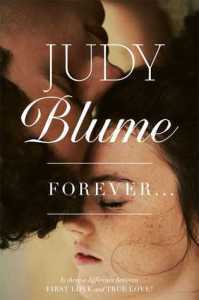
Atheneum Books for Young Readers, Reissue Edition, April 2014.
Jason: Good for those authors to take a stand. Harris Gray is with them – together we can get the inappropriate material out of our libraries. For starters I have never liked Judy Blume. That book FOREVER, it was like she knew every move in my teen toolkit, and broadcast it for all the girls to see.
Allan: The last thing we need is real life depicted in a book! Isn’t that what real life is for?
Jason: Life lays your soul bare — why would I want to see my naked soul in print? Curse you, J.D. Salinger!
Allan: Books are for fluff and fantasy. And vampires.
Jason: Woe to the day when our teenagers are walking around with their noses buried in books. We need laws against that as well.
Allan: Do you know how dangerous it is to cross the street with your nose in a book? Or drive while reading?
Jason: You could miss an important text!
Allan: I’m getting lathered up just thinking about it. Is it fair that Zuckerberg and those Twitter guys went to all that trouble creating the opportunity for us to share glamorized, sanitized snippets of our best selves, only to have authors expose our warts and inadequacies?
Jason: I do not want to see your warts. Any more of your warts.
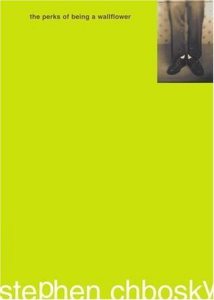
MTV Books, February 1999.
Allan: And I do not want to see a teenager look up from THE PERKS OF BEING A WALLFLOWER and recognize the nerdy introvert in me. I have worked my tail off to repress and Facebook away those memories!
Jason: You were a dork, weren’t you. It would have been so much fun to mock you.
Allan: Damn you, Stephen Chbosky!
Jason: I’m ashamed of these young adult authors, and the librarians who enable them. They all should be banned from reading anything other than Instagram and Snapchat.
Allan: And vampire tales.
Jason: Time to bring back the ways of our ancestors with an old-fashioned book burning.
Allan: Book burning is still hot, so to speak.
Jason: Sure, in Nazi Germany.
Allan: Nope, right here in the good ol’ U.S. of A. HARRY POTTER, 50 SHADES OF GREY…
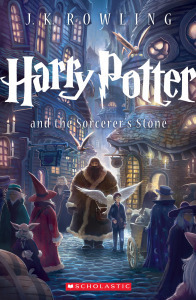
Scholastic, Reprint Edition, August 2013.
Jason: Whoa…Harry f-ing Potter? Sure, I’m jealous of J.K. Rowling, and I’d love to clear a little shelf space for us, but…
Allan: At the Amazing Grace church in North Carolina, they hold an annual book burning. Ironically they have even burned bibles.
Jason: Okay, I’m having second thoughts now.
Allan: You buck up, mister! Do you want authors to be free to write about your indecisiveness, for all the world to read?
Jason: I surely do not. Okay, I hope Banned Books Week catches on.
Allan: Me too. Now if you’ll excuse me, I need to tell my daughter to read FOREVER before it’s too late.
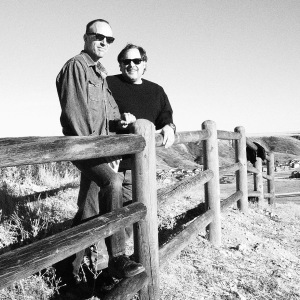
Harris Gray.
Harris Gray combines the writing talents of duo Allan Harris and Jason Gray. Together, they have written three novels, two screenplays, a Christmas play and a collection of stories from Jason’s younger days. An early version of their novel JAVA MAN was a finalist in the Rocky Mountain Fiction Writerscontest. Allan is a former guest columnist for The Denver Post and Jason owns Crowfoot Valley Coffee and Crowbar, land of rumor and embellishment.
Their collaboration began in Jason’s coffee shop. Allan wrote and eavesdropped as Jason entertained his customers. One day, Allan found a little yellow notepad waiting for him, crammed to the margins with Jason’s exploits. Allan typed them, touched them up, and called it good; but Jason had other ideas. As their tales converged and became inseparable, Harris Gray emerged. While the two couldn’t be more different in how they think and write, Harris says, “There is something wonderful and incredibly cohesive when we create a story together.” In Gray’s words, “We’re something less than Sybil and more than Siamese twins.”
VAMPIRE VIC, the first installment in the darkly funny and relatable trilogy, launched in March 2013. Readers can add the follow-up, VAMPIRE VIC2: Morbius Reborn, to their bookshelves this fall. Harris Gray also released their standalone novel JAVA MAN in November 2013.





Banned Books Month: Guest Post from Harris Grey (aka Allan Harris & Jason Grey): Let’s Ban Some Books
Jason: So it’s Banned Books Week, and it really got me thinking, about what books should be banned.
Allan: According to a blog post by Chris Finan, director of the American Booksellers for Free Expression, “In 2014–2015 there were efforts to censor Young Adult books by Sherman Alexie, Stephen Chbosky, Chris Crutcher, Emily M. Danforth, Barthe DeClements, Cory Doctorow, John Green, Ellen Hopkins, David Levithan, Stephanie Meyer, Jodi Picoult, Marjane Satrapi, and Raina Telgemeier.”

Atheneum Books for Young Readers, Reissue Edition, April 2014.
Jason: Good for those authors to take a stand. Harris Gray is with them – together we can get the inappropriate material out of our libraries. For starters I have never liked Judy Blume. That book FOREVER, it was like she knew every move in my teen toolkit, and broadcast it for all the girls to see.
Allan: The last thing we need is real life depicted in a book! Isn’t that what real life is for?
Jason: Life lays your soul bare — why would I want to see my naked soul in print? Curse you, J.D. Salinger!
Allan: Books are for fluff and fantasy. And vampires.
Jason: Woe to the day when our teenagers are walking around with their noses buried in books. We need laws against that as well.
Allan: Do you know how dangerous it is to cross the street with your nose in a book? Or drive while reading?
Jason: You could miss an important text!
Allan: I’m getting lathered up just thinking about it. Is it fair that Zuckerberg and those Twitter guys went to all that trouble creating the opportunity for us to share glamorized, sanitized snippets of our best selves, only to have authors expose our warts and inadequacies?
Jason: I do not want to see your warts. Any more of your warts.

MTV Books, February 1999.
Allan: And I do not want to see a teenager look up from THE PERKS OF BEING A WALLFLOWER and recognize the nerdy introvert in me. I have worked my tail off to repress and Facebook away those memories!
Jason: You were a dork, weren’t you. It would have been so much fun to mock you.
Allan: Damn you, Stephen Chbosky!
Jason: I’m ashamed of these young adult authors, and the librarians who enable them. They all should be banned from reading anything other than Instagram and Snapchat.
Allan: And vampire tales.
Jason: Time to bring back the ways of our ancestors with an old-fashioned book burning.
Allan: Book burning is still hot, so to speak.
Jason: Sure, in Nazi Germany.
Allan: Nope, right here in the good ol’ U.S. of A. HARRY POTTER, 50 SHADES OF GREY…

Scholastic, Reprint Edition, August 2013.
Jason: Whoa…Harry f-ing Potter? Sure, I’m jealous of J.K. Rowling, and I’d love to clear a little shelf space for us, but…
Allan: At the Amazing Grace church in North Carolina, they hold an annual book burning. Ironically they have even burned bibles.
Jason: Okay, I’m having second thoughts now.
Allan: You buck up, mister! Do you want authors to be free to write about your indecisiveness, for all the world to read?
Jason: I surely do not. Okay, I hope Banned Books Week catches on.
Allan: Me too. Now if you’ll excuse me, I need to tell my daughter to read FOREVER before it’s too late.

Harris Gray.
Harris Gray combines the writing talents of duo Allan Harris and Jason Gray. Together, they have written three novels, two screenplays, a Christmas play and a collection of stories from Jason’s younger days. An early version of their novel JAVA MAN was a finalist in the Rocky Mountain Fiction Writerscontest. Allan is a former guest columnist for The Denver Post and Jason owns Crowfoot Valley Coffee and Crowbar, land of rumor and embellishment.
Their collaboration began in Jason’s coffee shop. Allan wrote and eavesdropped as Jason entertained his customers. One day, Allan found a little yellow notepad waiting for him, crammed to the margins with Jason’s exploits. Allan typed them, touched them up, and called it good; but Jason had other ideas. As their tales converged and became inseparable, Harris Gray emerged. While the two couldn’t be more different in how they think and write, Harris says, “There is something wonderful and incredibly cohesive when we create a story together.” In Gray’s words, “We’re something less than Sybil and more than Siamese twins.”
VAMPIRE VIC, the first installment in the darkly funny and relatable trilogy, launched in March 2013. Readers can add the follow-up, VAMPIRE VIC2: Morbius Reborn, to their bookshelves this fall. Harris Gray also released their standalone novel JAVA MAN in November 2013.





September 24, 2015
Banned Books Month Guest Post from Sarah J. Schmitt: Why Teens Need Challenged Books
As a librarian and author, I talk about banned books a lot. And, I am often baffled by the challenging of books like THE ABSOLUTELY TRUE DIARY OF A PART-TIME INDIAN, THIRTEEN REASONS WHY and HARRY POTTER. Yes. I said HARRY POTTER. I find myself questioning if those filing the complaints have actually read the book they propose to censor or are just going off of what they think the books is about. Case in point, when I read about a magical orphan who is welcomed and loved by a group of people who come to think of them as their own son, it boggles the mind how the story could ever be challenged on the basis of being anti-family.

Scholastic, Reprint Edition, August 2013.
And when I get into conversations about challenged books with others, I often end the conversation with some variation of “sometimes a fiction story is just a story and people need to relax.” But I posit that teens need challenged books. And before you ask why, here’s the answer. Because we don’t want to talk about the subject matter contained in these book. They are stories about experiences and consequences that only a few decades ago were shameful and rarely discussed in public. And just because we talk about the subjects more, doesn’t mean they don’t make us uncomfortable. As a society, need to be made aware of these books. And authors need to be brave enough to write these books.
According to the Office of Intellectual Freedom, from 2000-2009, 5,099 challenges were reported. The top five challenge categories sited were “sexually explicit” material, “offensive language,” materials deemed “unsuited to age group,” “violence,” and “homosexuality.”
Now, for the purpose of this post’s length, I’m going to put aside the “offensive language” and “unsuited to age group” because those are two of the reasons CAPTAIN UNDERPANTS took the number one spot in 2013, and coincidentally, these are two of the same reasons used to challenge THE PERKS OF BEING A WALLFLOWER.

MTV Books, February 1999.
Just for a moment, let’s talk about sex, baby. “Sexually explicit” challenges, is a pretty broad spectrum. Questionable subject matter can run the gauntlet from consensual underage sexual experiences to pregnancy to rape and incest. These are topics that teens, regardless of gender, socio-economic status, or race are facing every day. One of the most powerful gifts of literature if the ability to make the reader feel like they aren’t alone. Like many characters in YA lit, there are teens who have had their innocence stolen from them. Or they have willingly decided to share their bodies with someone else only to have the act sullied by attacks via social media. And still there are others who have fallen victim to someone who was supposed to care for and protect them. They may believe there will be retribution if they speak up or fear the reaction from their friends and family when the truth comes to light. But when authors are willing to address the positive and negative issues associated with sex in an authentic manner, they create a safe space for teens to confront their own fears and maybe (hopefully) find the courage to speak up.
Let’s shift to violence. Now, as a K-8 librarian, this is one area I struggle with a bit. The reality is that there are a lot of YA books that could be considered violent and I do have an obligation to consider the innocence of ALL students who enter my classroom. In some cases, I have pulled books or restricted checkout to older students. And I am occasionally questioned about why certain titles are a part of the collection. (A side note: Last year, a parent brought up THE SISTERHOOD OF THE TRAVELING PANTS and asked why, at a Catholic school, a book where the main character has sex, would be available to her seventh grade daughter. My former principal’s response was “Has she read the Old Testament? If so, then she’s read much worse.” Best defense ever.) Back to my point regarding violence in YA lit. I think one thing that has increased the perceived level of violence in books being published is the trend of dystopian, which is, by its definition, is a society that is dehumanizing, thus setting the scene for extreme violence. But that kind of violence isn’t confined to fiction. Don’t believe me? Turn on the nightly news and you will see that the same violence referenced in the challenged books really isn’t fiction. It’s real and it’s happening right now. Millions of people are displaced as bombs destroy their home. The mastermind of the plan is the person who is supposed to lead them. Sound familiar? But we don’t even have to look to the other side of the world for violence. We live in a violent time. We live in a time where any small town Mayberry-esque could easily be the scene of a horrific murder-suicide. And these acts aren’t going to stop unless we talk about the underlying causes of violence. Mental health, institutional and societal racism, religious intolerance, and just plain hatred. We need books that make us take notice of the lives other people have lived and lost.
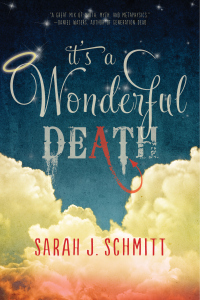
Sky Pony Press, October 2015.
So what about homosexuality? I don’t know if you’ve noticed it or not, but this year has been an outstanding year for YA literature addressing LGBTQIA issues. In case you don’t know what those letters stand for, they are Lesbian, Gay, Bisexual, Transgender, Queer, Intersex, and Asexual. I am proud that several of the authors of these books are also friends of mine and I applaud their efforts to give a voice to teens struggling with their own journey of coming out and living the life they deserve to live. And while we see the political landscape of our country evolving, the hearts and minds of the individual aren’t always as quick to change. There are still teens struggling to come to terms with who they are. They are afraid of what will happen when they tell their parents or their best friend. Characters in books have the ability to be an inspiration. We need characters that challenge the status quo and unfortunately, as a result, these amazing books I mentioned earlier might face challenges of their own in the coming years.
My point is that we don’t need more banned books. We certainly don’t need censorship. But we do need books that force us take a good hard look in the mirror and see the reality of our social reflection. We need books that can open the door to talking about the issues that teens face every day. We need books that give us an idea of what it’s like to walk in another human being’s shoes. We need books that show us how bad the world could be so that we can figure out a way to avoid it. Challenged books are important to the teen experience not because they are controversial but because they give us an avenue to evolve beyond the life we are born into. They give us hope and challenge our assumptions. In short. They make us better.
So read a book that’s on the challenged list. Find out what the fuss is about. And then talk about how it can make you better. BE FEARLESS when it comes to reading. You never know how it might change your life.
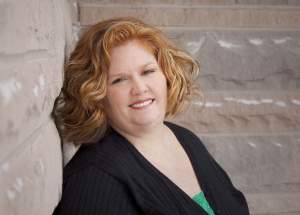
Sarah J. Schmitt.
Sarah J. Schmitt has bachelor’s degrees in political science and psychology as well as a master’s degree in higher education administration, but she has always loved writing fiction. She is a K-8 school librarian part-time and youth service professional for teens at her public library. Sarah currently lives with her husband and two kidlets near Indianapolis, Indiana.





September 23, 2015
Banned Books Month Guest Post from Erin Butler: A Librarian’s Point of View
As an author and a librarian, I have to deal with banned books in two different capacities. For the purpose of this post, we’ll call my daytime hat, the librarian side, and we’ll call my nighttime hat, the author side.
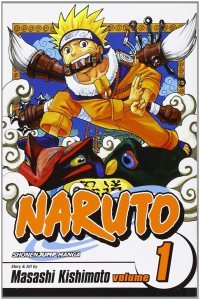
VIZ Media, July 2003.
When I hear a book has been banned, or “challenged”, my nighttime hat says “Oh, HELL no.” When my daytime hat hears the same thing, I say “Oh, HELL no,” BUT I also have to think about it with a level head. I know, I know, downsides of the daytime hat. I’d love to be able to ignore these trivial matters but funny thing about doing so in the job that pays the bills—I’d get fired.
My library recently had a patron who “challenged” one of our titles in the teen section. “Challenged” means they took the time to fill out a form explaining all the reasons why they felt the book should be removed from the shelves. (I’d love to be able to share that with you because I’m sure all you book-minded people would laugh right alongside with me, but unfortunately, I can’t.) The title in question was a very popular Manga series, NARUTO. You can find out more information about NARUTO here.
In my library, when books are challenged, the completed Materials Reconsideration form goes to an administrator and then the administrator chooses librarians to be on a Reconsideration Committee. Nice name, huh? Because the title was shelved in the teen section, and I know a thing or two about teen books, I was asked to serve on the committee.
When I got the email about the challenged book, that’s about the time I said, “Oh, HELL no.” Then, I read the form the patron filled out and laughed hysterically. But, I can’t just write my administrator back with something like, Hahahahaha. This is a joke, right? (If you’d read the materials reconsideration form, you’d understand.) Suffice it to say that the patron questioning the title was adamant that NARUTO be taken off the shelves. Why? Well, because of boobies of course. Two of them. On two different pages. GASP! And I’m not talking real-life images, this is Manga after all. The black and white cartoon drawings were of a bare-chested woman. One curved line and one dot threw this woman into a bout of anger strong enough to force her to take the time to fill out our form and await the decision of the Reconsideration Committee.
I will share with you the write-up the Materials Reconsideration Committee completed in response to the patron’s request, in which we, of course, suggest NARUTO stay exactly where it is on the Teen Manga shelf.
Naruto: The Tests of the Ninja is the first volume in an ongoing Japanese manga series written and illustrated by Masashi Kishimoto. First published in Japan in 1999, Naruto was a well established series before libraries in the United States began purchasing the titles. The series is available at many of the city and suburban library branches that make up the Onondaga County Public Library system and is one of the top circulating manga series on the shelves. It is also one of the best selling mangas of all time, having sold more than 113 million copies in Japan and more than 4.8 million in the United States.
The opinion of this committee, regarding the Material Reconsideration of Naruto Volume 1: The Tests of the Ninja, is that the title remain as shelved in the Teen/Young Adult area among the other Graphic Novel and Manga titles. The reasons are as follows:
There is a significant demand for this series from teens resulting in high circulation statistics and holds.
Mangas often reflect the fact that Japanese audiences are less adverse to representations of nudity and violence in their culture. It is not, however, far from current mainstream television and print.
The specific drawings of nudity and violence are of a cartoon nature and are neither detailed nor life-like enough to truly be considered damaging to teen minds.
The publisher, Viz Media, a highly respectable publisher in Manga and Anime, has rated this book T for Teen. The company’s rating system is as follows: A for All Ages, T for Teens, T+ for Older Teens, and Mature for Adults Only.
The series has been included in professional lists as a must-read for mangas, including the Manga Core List put out by the Youth Services Department of the Utah State Library (Manga-Core-List.doc) and the 2009 Great Graphic Novels for Teen list from the American Library Association’s Young Adult Library Services Association (2009 Great Graphic Novels for Teens Young Adult Library Services Association (YALSA))
Libraries traditionally expect the parents of children and teens to monitor their reading material, and exclude them from reading and viewing material which they deem inappropriate.
Fortunately, administration listened to our suggestion and NARUTO is still exactly where it should be.
Unfortunately, this isn’t always the case with challenged books throughout the country. I don’t have a problem with people choosing not to read a book because of their personal beliefs, but I do have a problem with people taking away others rights to decide. This “babysitting” mentality the world has today about saving others from potentially dangerous material might—no, is—harming us. Who am I to say what reading material is appropriate for everyone? In fact, I’m a big fat nobody. I’m not fighting for material to be read by all, I’m fighting for people to have the choice. One of the great things I believed we had in this country was choice—that we can decide for ourselves whether or not we want to read something. By taking a book out of a public—or even school library—you’re taking away that person’s right. Their library might be the only source they have to get that information. Maybe they can’t afford an e-reader. Maybe they can’t afford to take the bus to the next library system. Maybe they can’t afford to purchase the title from the local Barnes & Noble.
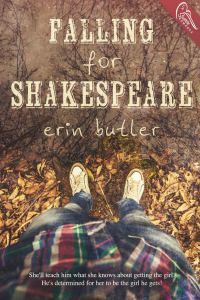
Swoon Romance, September 2015.
Specifically for NARUTO, the series is so popular among teens and especially with reluctant readers. If I were to make a leap, knowing what I know about teens and the power reading can have on their education, I might say that by taking NARUTO out of the library, we would be affecting teens’ rights and their mind. It’s no surprise to any of us that reading is fundamental to education, and in fact, plays a very important role in their learning.
Indulge me if you will in this little scenario. Billy, a thirteen-year old boy struggling to keep up in school, has been told by a friend to read NARUTO. After hearing that NARUTO has a bunch of comic book-like pictures, Billy is actually interested in reading it. He walks up to the librarian’s desk and in a timid voice, asks, “Do you have NARUTO here?” Peering over the large desk, the nice, friendly librarian says, “No, honey, we don’t.” Billy shrugs and walks away.
We missed an opportunity there—a big opportunity—because some self-righteous, crusty patron who thinks they know what teens need and don’t need in life took our power away. Because some worried, smug patron thought those two small pictures of cartoon breasts would affect Billy more than not reading.
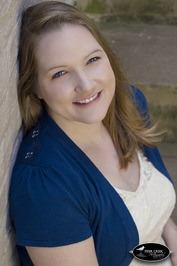
Erin Butler.
Erin Butler is lucky enough to have two jobs she truly loves. As a librarian, she gets to work with books all day long, and as an author, Erin uses her active imagination to write the kinds of books she loves to read. Young Adult and New Adult books are her favorites, but she especially fangirls over a sigh-worthy romance.
She lives in Central New York with her very understanding husband, a stepson, and doggie BFF, Maxie. Preferring to spend her time indoors reading or writing, she’ll only willingly go outside for chocolate and sunshine–in that order.
Erin is the author of BLOOD HEX, a YA paranormal novel, HOW WE LIVED, a contemporary NA novel, and the YA contemporary romance titles, FINDING MR. DARCY: HIGH SCHOOL EDITION and FALLING FOR SHAKESPEARE. Find out more about her at www.erinbutlerbooks.com or @ErinButler on Twitter!





September 22, 2015
Banned Books Month Guest Post from Wendy Terrien: Ban My Books, Please
I grew up in Salt Lake City, Utah. That statement alone might make you think I had a HUGE list of banned books to choose from. After all, banning things “for the good of society” is not uncommon in Utah. A cinema chain refused to screen Zac and Miri Make a Porno—a movie deemed by industry-types to be a rom-com. Not the actual making of said porno. A similar fate came to Academy Award winner Brokeback Mountain.
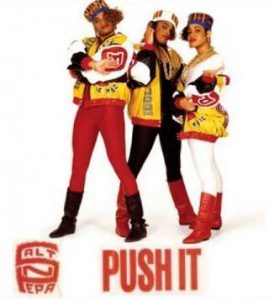
Salt-N-Pepa, 1987.
The song “Physical” by Olivia Newton John was banned from radio stations in Salt Lake City and Provo after it was released in 1981. And if I remember correctly, Salt-n-Pepa’s song “Push It” was only played on the radio after midnight. Nothing good happens after midnight, you say? Not in this case, because that song is definitely good, even today. But I digress.
Regarding banned books in Utah, the list is relatively modest (key word: relatively). An article published in the Salt Lake Tribune in 2013 quotes librarian, Wanda Huffaker, saying, “We don’t ban a lot of books.”
What??
I thought books would be an easy target—much more so than movies or music, where the masses are more likely to notice they’re being denied a blockbuster or hot new beat. Unless they’re highly anticipated, books can simply be pulled from a shelf, added to a secret do-not-talk-about-this-book list, or never stocked at all. And certainly Utah has participated in the banning of books, but it seems they haven’t been any more ridiculous about it than anyone else.
 In fact, when I was in school in Salt Lake City, I never heard one word about books I shouldn’t read or wouldn’t be allowed to read. I was actually assigned to read THE GREAT GATSBY and THE CATCHER IN THE RYE. Not to mention THE GRAPES OF WRATH and TO KILL A MOCKINGBIRD—the first four books on the American Library Association’s (ALA) list of banned and challenged classics. Go figure.
In fact, when I was in school in Salt Lake City, I never heard one word about books I shouldn’t read or wouldn’t be allowed to read. I was actually assigned to read THE GREAT GATSBY and THE CATCHER IN THE RYE. Not to mention THE GRAPES OF WRATH and TO KILL A MOCKINGBIRD—the first four books on the American Library Association’s (ALA) list of banned and challenged classics. Go figure.
But what about more current titles? Writers are pushing the envelope more, right? So what kind of nasty, foul stuff is hitting the banned book list these days?
While I didn’t find a comprehensive list specific to Utah, I did see the ALA’s list of the top ten most frequently challenged books of 2014. Top of the list, and not nasty or foul in the slightest, is THE ABSOLUTELY TRUE DIARY OF A PART-TIME INDIAN, by Sherman Alexie.
Seriously.
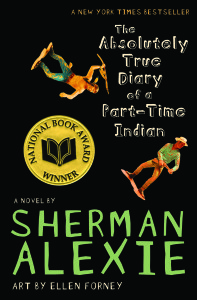
Little, Brown Books for Young Readers, September 2007.
Reasons given for its call to banned-dom: anti-family, cultural insensitivity, drugs/alcohol/smoking, gambling, offensive language, sex education, sexually explicit, unsuited for age group, violence. Additional reasons: “depictions of bullying.”
I read this book. It’s been a couple of years, but as I reviewed the list of reasons-to-be-banned, for the most part I found myself trying to recall how it could be anti-family or show cultural insensitivity. Or be sexually explicit. Maybe it’s there, but it didn’t impact me enough to be shocked or stunned or to reject the book in its entirety.
As for drugs/alcohol/smoking, gambling, and offensive language, I saw all of that in my own school, so reading about it would hardly be shocking or turn me from the wholesome path on which I walked (what can I say, I was a model child through high school). And hello – same goes for “depictions of bullying.” Sadly, bullying is part of the elementary through high school experience (and yes, sometimes beyond). Hiding books with scenes that depict what kids may be going through in their own lives hardly makes it go away.
I understand the motivation behind why someone might decide a book should be banned. We want to protect our children, we want to spare them growing up too fast, we want to make sure they have the best childhood experience possible. Those are all sound objectives, worthy of action. But banning books is not going to achieve that goal.
Kids of all ages deal with bullying, they hear and use swear words, and they’re curious about, or already using drugs and alcohol and cigarettes, whether they’ve read about them or not. To ban books that depict any of that, and more, is a disservice to children and adults alike. Books bring relatable moments into our lives, show us new or different perspectives, and introduce ideas that the reader may not have previously considered. Books bring moments of learning, a chance to share between adult and child, an opportunity to teach and to guide. Books bring questions and an occasion to build the relationship. Books help us grow. To ban books is to squash that opportunity.
All that being said, banning a book today usually translates to bigger sales numbers for the author, and consequently more eyes on “troubling” pages. That translates to more opportunities for kids to see themselves in a book, to relate to a scene, a chapter, or a character. And to feel like maybe they’re not the only one going through something that had, until that book showed up in their hands, made them feel alone or anxious or sad.
So even though the reasoning behind banning a book is shaky, go ahead and ban those books, book-banning-people. In fact, please feel free to add mine to the list for 2016 (it has teenagers swearing!).
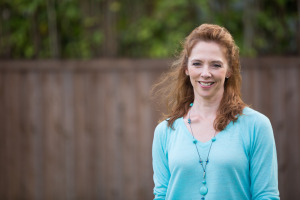
Wendy Terrien.
Wendy Terrien is an author of young adult fiction who has written stories since her age was in single digits. Having studied organizational communication and business, and worked her way up the corporate ladder at a number of organizations, she’s happy to be letting her inner creative self run wild.
Wendy is a member of Rocky Mountain Fiction Writers, Pikes Peak Writers and the Society of Children’s Book Writers & Illustrators. She lives in Colorado with her husband, Kevin, and their three dogs, Maggie, Shea and Boon. In 2014, she was a finalist in the San Francisco Writer’s Contest and will be releasing her debut book in February, 2016.





September 21, 2015
Banned Books Month Guest Post from Blaise Larmee: Help!
On July 3rd of last year I received the sort of email that’s every author’s worst nightmare. 1500 copies of my photobook had been seized by the Canada Border Services Agency (CBSA) at Port Alice.
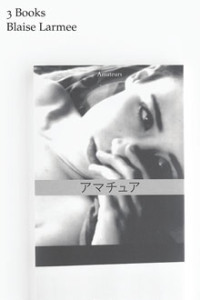
2dcloud, June 2015.
A month prior, new legislation put a chill on certain publishing activities in Japan. Not knowing what to do, my Tokyo-based publisher decided to ship the entire print run of my book to the warehouse of their North American distributor in Montréal.
The age of the model I used was called into question. Although most distributors would describe the book as a ‘photobook’, I pushed for ‘manga’ as an secondary category, raising an immediate red flag.
We were given a 30 day window to prove our innocence or else the books would be made permanently unavailable to us. In other words, they would be destroyed.
I flew into Vancouver Island a week later, bringing documents including a release form, a copy of the model’s state ID, and, if needed, several letters from friends and colleagues testifying to the book’s literary and artistic merit.
The agents I met with showed me nothing but contempt. Because the photos were taken on the model’s 18th birthday there was the suggestion that she was still 17 at the time in Japan. Similar technicalities, delivered from a moral high ground, were employed throughout the meeting.
The resulting loss was one of a series of factors that led to the publisher’s demise a few months later. Only the proof copy survives. It serves as a daily reminder of the capriciousness of the laws and agencies to which books are subjected.
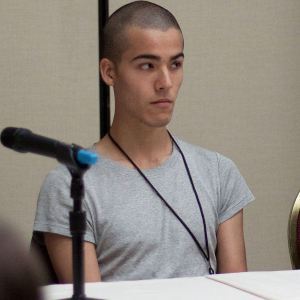
Blaise Larmee.
Blaise Larmee (b 1985) is an American author. 3 Books (2dcloud, 2015) collects a book of drawings, a photobook (the subject of this article), and a catalogue of paintings. He has recently finished work on the first issue of Altcomics Magazine, a behind-the-scenes glimpse at the vibrant altcomics scene. His website is blaiselarmee.com.





September 20, 2015
Banned Books Month Guest Post from Anne Boles Levy: Making Our Own Choices
My parents never set any restrictions on what I could or couldn’t read. Anything in print was fair game, even the books on a musty basement shelf put deliberately a little out of reach – not enough to seem off-limits, but just enough not to be obvious.
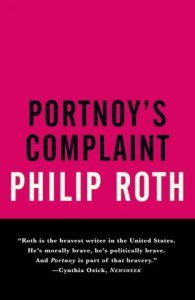
Vintage, Reprint Edition, September 1994.
That’s where Mom, a nurse, kept her anatomy text, and Dad put his leather-bound set of the Harvard Classics. And where I found Philip Roth’s PORTNOY’S COMPLAINT the summer I turned 16. I was living in the basement, thanks to some houseguests who either couldn’t or wouldn’t leave and took over my sunlit bedroom.
I’d been banished to the basement office, with its mildewy shag carpet and brown-paneled walls. One tiny, cobwebbed window shed weak light onto a lumpy metal cot Mom had set up for me. It was 1979, and I spent my summer nights with Blondie cranked up on the FM dial, reading under the flickering overhead light with books plucked from the not-obvious shelf. My parents were smart and well-read, with eclectic tastes, so I made short work of John Hersey’s HIROSHIMA and Ray Bradbury’s FAHRENHEIT 451, a collection of Isaac Asimov short stories … and Roth.
At first, I didn’t know what to make of the strange, meandering confessions of a Jewish everyman in search of the perfect blow job, preferably from a blonde, gentile woman. I wandered around the house with it, leaving it neatly bookmarked as Mom always insisted, not thinking about my parents’ possible reactions. It didn’t occur to me they’d object. They never did.
I decided it was more annoying than shocking. I knew a lot of Jewish men – having been born into a family of them – and no one I knew matched Roth’s whiny, neurotic, sex-obsessed wretches. I dismissed the book as not-my-taste and not-my-reality.
When I’d finished, a different book appeared in my hands – I don’t recall which one. I read them the way chain smokers light up one cigarette with the butt end of the last.
Finally, my parents caught me wandering through the family room in my usual distracted fog and asked, ahem, what I’d thought of PORTNOY’S COMPLAINT? Dumb, I said, with all my teenager wisdom. And pornographic, though not interestingly so.
They sighed in relief, exchanged glances, and smiled.
“We wanted you to make up your own mind,” Mom said.
Dad nodded.
And life went on.
So I grew up in a bubble of sorts, privileged with smart, savvy parents who trusted me and also trusted the way they’d raised me. The only people who banned books that I knew about had worn swastikas on their sleeves, and they’d burned those books. And then they’d burned people. My people. The association between book banning and barbarity was writ large in my brain from an early age.
My father had served in World War II, stationed in Egypt, and spoke of the ancient burning of the great library in Alexandria with a sigh of remorse, as if he’d personally witnessed the destruction of thousands of irreplaceable texts.
Such a loss, he’d say. All that knowledge. Gone.
The rules in our household had therefore been unspoken, and all the more powerful because of it: I could read what I liked, and I didn’t have to like what I read. But once released into the world, a book had its own, independent existence, one that grew larger than the person who’d written it and long outlived him or her, and belonged to those who would read it, now and forever.
So a decade later, when Salman Rushdie found himself on the Ayatollah Khomeini’s bad side, I didn’t hesitate to strike my tiny blow for free speech. His SATANIC VERSES had angered the extremist Iranian cleric, who’d issued a fatwa, or death warrant, that extended to his translators and had booksellers around the world cowed. I was living in New York City at the time, struggling on my meager pay as a secretary for a textbook publisher, but I marched down to the bookstore with the biggest window display and shelled out $10 or so that I didn’t exactly have.
Alexandria wasn’t going to burn a second time while I could help it.
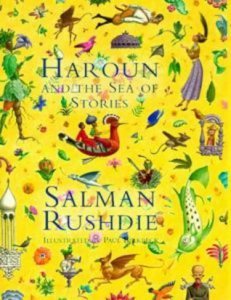
Viking Children’s, Reprint Edition, August 1999.
The book disappointed – I don’t think I got to chapter two, to be honest. That purchase bought me street cred, however, when addressing my 8th graders last year as we discussed another novel of Rushdie’s, HAROUN AND THE SEA OF STORIES, which he’d written for his pre-teen son while on the run. Students soaked up its wondrous, witty blend of Eastern and Western cultures.
But what won them over is the idea that Rushdie didn’t quit, didn’t give in when censored, and wouldn’t be silenced. And neither would we, the American reading public. I read to students an excerpt of a letter Rushdie wrote to US bookstores, who were largely alone in defying the fatwa:
“The independent booksellers of America put the book in windows, mounted special displays, and courageously stood up for freedom against censorship, refusing to allow the choices of American readers to be limited by the threats of an angry despotic cleric far away.
“The bravery of independent booksellers influenced other stores to follow their lead, and in the end a key battle for free expression was won—not by politicians who, as usual, arrived cautiously and tardily at the battlefield, but by the determination of ordinary people that it not be lost” (from Salman Rushdie’s JOSEPH ANTON).
Whenever I’m dismayed that books still get yanked from American shelves, I think of both Roth and Rushdie, about the choices we make and the trust we bestow. I remind myself that there are nearly 120,000 public libraries in our country, and nearly 13,000 bookstores. Last year, the American Library Association logged just 310 reports of challenged books.
It’d be so easy to be scared by that number. But I’m not. For every classroom in Arizona that was forced two years ago to remove Sandra Cisneros’ THE HOUSE ON MANGO STREET when so-called Ethnic Studies were banned, there were teachers like the one in my school who immediately put it on her syllabus. In Arizona. No one got arrested, the state superintendent lost re-election, and a movement was launched.
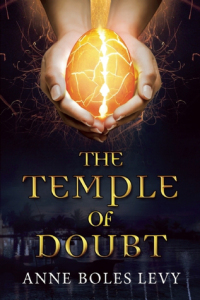
Sky Pony Press, August 2015.
The First Amendment is still the law of the land. Far from failing in our duty to protect innocent eyes from unseemly things, we authors, teachers, librarians, and parents are doing the daily work of a democracy by encouraging what Supreme Court Justice William O. Douglas called the free marketplace of ideas.
My parents died along ago, but I remember their trust. I see in my students a similar willingness to come to their own conclusions, and a fierce desire to support others’ right to do so as well.
In time, they will be the ordinary people Rushdie spoke of, and this battle will be theirs.
Let’s trust them to make up their own minds.
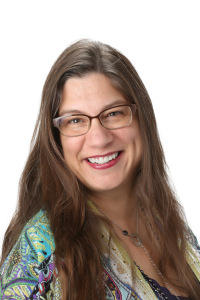
Anne Boles Levy.
Anne Boles Levy currently teaches English to middle schoolers after more than two decades writing and editing for print, web, and radio. Anne is a graduate of Smith College and studied abroad at University College London, and she has her master’s in journalism from Columbia University. She cofounded and now runs the Cybils Awards (www.cybils.com), the only awards by book bloggers for kids’ and young adult titles. She’s also an amateur silversmith and the absentminded wife to her long-suffering husband, Brett. They run around after two children and a cat in Scottsdale, Arizona.





Banned Books Month Guest Post from Ann McMan: I Am Spartacus
I’ve spent the better part of six decades trying to connect the dots.
During that time, I’ve had some modest success. The pictures that emerged were pretty good, and frequently entertaining. Creating them was a lot like indulging in a real life version of the iconic Highlights magazine puzzle. Once I got a pirate ship. Another time I thought I could make out the figures of two young girls, drifting on inner tubes down a river of fire. That image was akin to one of those standard psychological tests—the ones where you’re asked to describe what’s taking place in an ambiguous photograph.
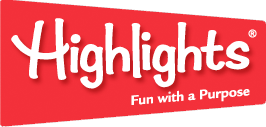 “I see Mommy hitting Daddy on the head with an axe.”
“I see Mommy hitting Daddy on the head with an axe.”
I was always pretty good at those, too.
Enter writing. Telling stories became a lifeline for me—a rope ladder that I could use to haul myself out of the muck and emotional moribundity that lined the sticky pit of my life.
I didn’t want to burnish my chains—I wanted to break them.
So I told stories. A lot of them. And even though I sometimes allowed myself to wander off the paved roads that traversed the landscape, I mostly confined myself to roaming The Known World. It was safer there. Friendlier. I know where I was going and when I’d get there. I even had maps. And there were featured attractions along the way. Quirky things—like roadside restaurants that came equipped with handy phone apps so I could transmit my orders in advance of arrival.
Nifty. Neat. No surprises.
Hamlin Garland called these literary highways Main Traveled Roads. They’re comfy. We recognize them. We know every dip and sag in the pavement. We have our favorite rest stops all picked out—and we can linger over those as long as we choose. They’re familiar. They’re safe. And they don’t scare or challenge us.
But what happens when we stumble across something that does challenge us? That does threaten the bastions of what Toni Morrison called the temples of our familiar?
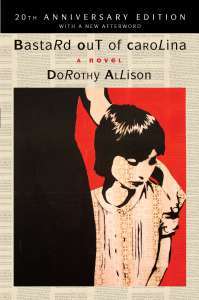
Plume; Reprint Edition, February 2012.
Chaos ensues. We panic. We circle the wagons. We vow to protect our children. We collude in our ignorance and fear and we conspire to silence the voices of authors who dare to disturb our pretty peace. And one of the best weapons in our arsenals is the ability to ban the books they write. We label them as obscene—or too graphic, too violent, too rife with harsh content that is inappropriate for children.
Dorothy Allison’s novel BASTARD OUT OF CAROLINA didn’t enter my life; it exploded in the middle of it. Allison is an irreverent prophet. A bombastic soothsayer. An unapologetic teller of truth. A teller of my truths, as it turned out. Because her story about Bone, a feisty 11-year-old girl who survives a childhood predicated by emotional, physical and sexual abuse was also my story. I always knew my own truths, of course—but it had never occurred to me that giving voice to them would offer me a kind of freedom that I’d never known before. Learning that there were other girls like me—like Bone—gave me permission to speak my own truths, and the courage to understand that calling my own demons by name was the only way I could derive them of their power.
Unfortunately, not everyone shared my epiphany.
BASTARD OUT OF CAROLINA, Allison’s first novel, was a finalist for the National Book Award in 1992. It has been celebrated by literary critics as “close to flawless.” Allison has been hailed as one of the finest writers of our generation. Yet this semi-autobiographical novel that dared to speak the truth about family violence and incest soon found a home on the banned books list in multiple states.
The power of BASTARD OUT OF CAROLINA is both emotional, and political. “The novel is mean,” Allison says, “meant to rip off all that facade of imagination and lies we place around sexual violence and children.”
Not age appropriate. That’s what they said about it. “The story is too graphic in its depictions of sexual violence against children.” One enterprising school administrator in California even suggested, “there are characters [in other books] out there that go through rape and abuse that have better endings.”
I guess “better endings” are always considered more age appropriate. Unhappily for me and at least one-in-four other girls growing up in America, those “age appropriate” stories didn’t much parallel the real lives we went home to after school. But then, we were encouraged to maintain our vows of silence because our lives—like the banned books that dared to describe them—were considered unfit topics for public discourse.
“I had imagined my novel would be a catalyst for clarity and compassion,” Allison wrote in her afterword to the 20th anniversary edition of BASTARD OUT OF CAROLINA, “not an impetus to anger and repression.”
In her memoir, TWO OR THREE THINGS I KNOW FOR SURE, Dorothy Allison explained that her job as a storyteller was not to make anyone happy. “What I am here for is to claim my life, my mama’s death, our losses and our triumphs, to name them for myself.”
But for me, the damage of Allison’s nearly perfect prose had already been done. Her words surrounded me. They resonated in my ears. Pounded in my viscera. Her truth filled up my world. And it reached down inside me to that secret place where my own truths lay hidden in their endless half-sleep—always with one eye open. She saw me. She knew me. And she called me out.
“In the writing,” she explained, “I had thought that if I get this right, I can change so much—how people think about rape and child abuse, and working-class families and the nature of resilience, and even perhaps something about how love can both save us and not save us. But also in the writing, I had thought that there was no way to get anything that right. All I could really do was tell a story the best way I could and hope to nudge some people’s notions a little more toward understanding what still does not make sense. Why would anyone beat a child? Why would anyone rape a child? Older and full of the world’s experiences as I am, I still do not know the answer to these questions.”
I don’t know the answers either. But I do know that silencing the voices of the prophets has never served us well. Education isn’t simply about rote memorization and the blind assimilation of facts. Learning requires analysis and critical thinking. Learning involves socialization and learning how to function in a complex society. Students are always better served by reading about diverse topics in a rich environment that encourages honest discussion. Safe and guided venues for thoughtful examinations of uncomfortable or controversial topics are essential to help young minds develop the cognitive skills needed to survive in an increasingly brutal and chaotic world.
“What banning books does,” Allison explained, “is continue the denial, extend that damage, and block any way for us to come together and address the reality of violence within our families and communities. We know this even as we go on wanting a world in which we do not need to tell these stories at all.”
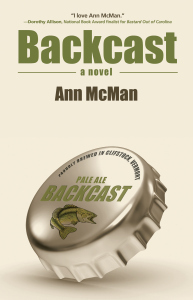
Bywater Books, December 2015.
I am a teller of stories. I am a survivor of incest and domestic violence. I am Spartacus.
Daring to read this courageous banned book saved my life.
Writer Dorothy Allison taught me that to be my best self, I must be willing to tell the truth. I must be naked on the page. I must learn to reveal myself, and the things I’ve learned, in the stories I tell. If I don’t, I shortchange my readers. If I don’t, I waste their time. If I don’t, I embrace shame and secrecy and not life.
“My daddy was a son of a bitch, and my mama didn’t love me.”
I tell stories to live, she said. I tell stories to survive.
Maybe that school administrator in California got one thing right—sometimes, if we dare to speak the truth, there can be better endings.
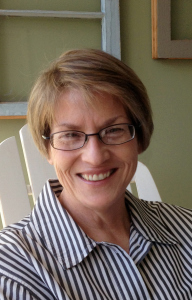
Ann McMan.
Ann McMan is the author of five novels, JERICHO, DUST, AFTERMATH, HOOSIER DADDY, and FESTIVAL NURSE, and the short story collections SIDECAR and THREE. She is a recipient of the Alice B. Lavender Certificate for Outstanding Debut Novel, and a two-time winner of the Golden Crown Literary Award for short story collections. Her novel, HOOSIER DADDY, was a 2014 Lambda Literary Award finalist. Bywater Books will release her semi-autobiographical novel, BACKCAST, in December of 2015.





September 19, 2015
Banned Books Month Guest Post from Jeff Buchanan: Plunged into Censorship
Censorship is something most of us may be aware of, be ardently opposed to, but aren’t necessarily directly affected by. Like horrible, rare diseases; we know they’re out there, read about them, have compassion for people who suffer from them, but for the most part we remain one-step removed. Untouched. That was certainly the case for me with regard to censorship.

Cinenovel, 2015.
This all changed last year when I went from spectator to participant in a case of censorship. A mild case perhaps, especially when put alongside more serious concerns such as the oppression of religious beliefs or political freedoms, but censorship none the less. My particular story has to do with an artistic project. My creative partner and I had undertaken an experimental, labor-intensive e-publishing endeavor that combined photographic elements, actors, sound and sets with a 50,000 word literary manuscript to create a unique, fully immersive, visual/reading experience. The use of cinematic-styled images with fades and dissolves necessitated tailoring the project exclusively to the advanced capabilities of the iPad.
The project, with its myriad challenges, had taken us quite literally years to bring to fruition. We had finally completed our “Cinenovel”; an innovative new genre novel/app comprised of an epic 500 lush photographic iPad frames that told the surreal tale of a fighter pilot named Icarus who flew for a modern Mt. Olympus. We exhaled, and proudly submitted our finished baby, THE PLUNGE OF ICARUS, to Apple.
Less than four hours later we received their response. A categorical rejection due to “objectionable material.” Four years of ceaseless work. Stopped dead, in four hours. I honestly thought there had been a mistake. First, because I felt there was nothing vulgar or distasteful anywhere within those 500 frames to constitute “objectionable material.” After all, this was merely a science-fiction story, a surreal near future fiction. Most TV shows contained a great deal more explicit images and dialog than what we had proffered. Also, I was surprised at the speed with which Apple had arrived at its decision. Four hours—to review a 500-frame/50,000 word literary work? Certainly they hadn’t read it.
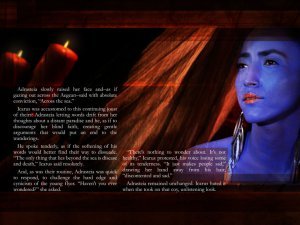
From inside THE PLUNGE OF ICARUS.
It came to light that out of the 500 frames that made up the project, the 28 that contained mild nudity were cause for the rejection. It may be of interest to note that despite advice from outsiders who suggested hedging the truth, I had answered all of Apple’s App Developer submission questions honestly and accurately. I had submitted the project in the 18+ category and had checked the box pertaining to nudity and strong language. I had been completely transparent and forthcoming. Furthermore, in our own attempts to assure people were not offended, we had placed labels on our website and inside the front cover page of the project that read; Warning: contains mature themes. Reader discretion advised. We did this of our own accord to ensure no one would stumble upon anything that might offend their personal views.
After the arduous process of creating the book, overcoming the enormity of hurdles of technical and financial hardships and challenges, it never occurred to me that the work would succumb to a judgment of censorship. Not a judgment of theme, or language, or politics, simply 28 frames of nudity. Adding to my bewilderment was the fact that we had crafted our project for the iPad in iOS. In doing so we were now stranded, banned from distributing and selling our project on the one distribution avenue available to us. A mood of helplessness permeated our humble little office.
Over the next few nights, repeatedly stirring awake in fits of anger and frustration, I did what no creative person, what no artist should ever have to do. Although I wanted to fight from the point of artistic integrity and freedom of expression, the reality was I was screwed. After deep deliberation I decided it necessary to try and appease the censors in order to not lose all we had worked for.
Given the situation, the reality that I owed investors a great deal of money, and feeling it was futile to wave the artistic flag too vehemently, I decided we had to alter the frames, remove the offending aspects until it was accepted. And so started the process. We went into the frames we had so carefully crafted and gradually began a ritual of destruction, obscuring the images. We resubmitted and were, categorically rejected again. “Objectionable material.” I saw those two words so often I began to dissect them in earnest, wondering what their definition was. During the hiatuses between further desecration of our frames and resubmission I spent the waiting hours perusing the iTunes Store. I found it interesting that there was an extensive catalog of music that in some cases had lyrics that promoted or celebrated violence as well as carried strongly misogynistic themes. Also, a host of violent video games were available. The games didn’t seem to have any parental control with regard to purchasing. We soldiered on in our continuing obscuring of our beautiful frames amidst an environment of confusion.
Eventually, after having obscured the 28 offending frames to little more than splotches of color, and having added ridiculous-looking, computer-generated breastplates to cover the female protagonists’ breasts, we finally received acceptance. It’s an ugly, shameful feeling to go in and willfully destroy your own work to accommodate the perceptions, opinions and morality of others. The victory—if one could call it that—was bittersweet. We sheepishly accepted our place as a new genre novel/app in the iTunes Store. Instead of celebrating the culmination of all those years of work, we softly retreated in shame.
Friends and colleagues were up in arms about the actions of Apple to level their will against an artist’s work, and started calling it an act of censorship. Strangely, it was I who defended Apple, reminding the aghast that Apple was, in fact, a private company and entitled to extolling their principals and morality any way in which they saw fit. That said, it did make me wonder about the varying degrees of censorship within a large company or government and how that invariably would lead to contradictory practices. How does one effectively measure a fair and just judgment against concerns involving artistic expression? Religious practice? Political leanings? It’s extremely arbitrary, prone to confusion and unfairness, teetering on hypocrisy.
Without question, there are situations where people flagrantly invoke the first amendment, grossly bend the rules to exploit a situation. This is where measures of control are to be employed in the form of labels and warnings, to ensure people aren’t subjected to something they may find offensive, but at the same time allowing them to decide for themselves what is or isn’t suitable for their intake. What then, when that choice is suppressed?
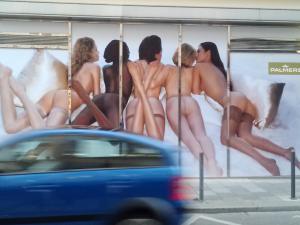
A German ad campaign. Photo by Jeff Buchanan.
A month after the defiling of our 28 frames to comply with Apple’s ruling I was in Germany on business. Emerging from the subway into downtown Munich I came face to face with a huge wall poster advertisement that involved the naked bodies of five females wearing nothing but stockings. Five naked women frolicking on a bed together, their posteriors on full display for passersby. No one appeared offended.
The following week I was in Iowa. I had stopped along a field of green corn bordering the highway. Situated strategically at the edge of the cornfield, in full view of the passing traffic, was a small trailer with a sign mounted on it that had inter-changeable plastic letters. On it was a Biblical passage accompanying a statement that abortion was a sin. A large, full color photo of a bloodied, aborted fetus accompanied the message. Regardless of your stance on a woman’s right to choose, to me, this was a disturbing visual, inappropriately presented in a public place on full, uncensored display in America’s heartland, for every motorist, every decent person, every passing school bus carrying young children to school, to see and ponder the image of the aborted fetus. Where was the censorship here? Who was watching out for the fragile young minds that would be passing by each day on their way to school? I found I was biting my lip with a kind of confused bewilderment of recollection; forced to alter 28 frames of nudity in order to get my Cinenovel into circulation; a public display of nudity on the streets of Munich; a troubling use of freedom of speech in Iowa. So, who decides what gets seen, by whom, where, and how?
Several months after the defiling of our 28 frames we created a static version of our Cinenovel, which I should point out, was accepted unaltered and without incident onto the iTunes Store as an iBook. In the end, when people see the frames in question in their original form, they will most assuredly wonder what all the fuss was about.
In writing this, there has been an acute awareness that I may, in fact, be cutting my throat with regard to future dealings with Apple. It would be very easy for the largest company in the world to undo a small entity like Cinenovel. But I decided it was perhaps the only way to deliver myself from the earlier personal disgrace of rolling over and destroying the frames I had created to tell my story. This particular situation, when compared to religious or political persecution, may seem trivial; the obscuring of an artist’s vision with regard to a fictional ebook. But it is oppressive none the less.
Epilogue: Jeff Buchanan and Jasser Membreno are at work adapting their Cinenovel, THE PLUNGE OF ICARUS for the Kindle. We shall see.
Visit www.cinenovel.com to learn more.
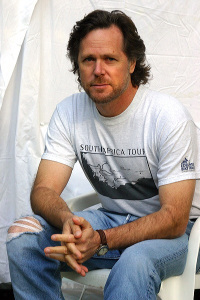
Jeff Buchanan.
An award-winning commercial director and film producer, Texas-born Jeff Buchanan has embarked on a new path, one which combines his love of the written word with visuals. Partnering with artist Jasser Membreno they have created an innovative, fully immersive visual/reading tablet experience under the trademark, Cinenovel. Their first title, THE PLUNGE OF ICARUS has cemented their conviction to pursuing development of this exciting new genre. Needless to say, Buchanan has taken leave of the film industry to concentrate on their new genre of Cinenovels.





Banned Books Month Guest Post from Beth Vrabel: On Being the Banner
Look, okay, we all know banning books is a stupid idea. (Even THE LORAX was once challenged for using the word stupid. Talk about, you know, stupid.)
Yet here I am at the library, divvying up the stack of books my daughter brought to me into two piles: Go Ahead and Not Yet. (There also is a secret I’m-taking-this-but-you-can’t pile, but she doesn’t know about that one.)
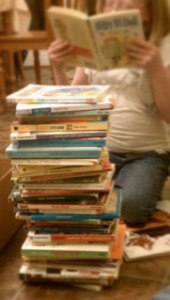
The Go Ahead pile after library sales can reach epic proportions, like this one from several years ago.
It’s a strange thing to be a lover of words and go from staunchly defending the right for anyone to read whatever book they want to read to being the gatekeeper, deciding which stories will be absorbed by a blossoming soul entrusted to my care.
I remember a particularly entertaining trip to the library when my son was three. I picked up a book about a werewolf who desperately wants to eat the love of his life. “Do you think that’s appropriate, Mama?” he asked me, pointing to the cover of the full moon and bare-chested teenage wolfboy.
I put it in my bag and shooed Pint-sized Judgy McJudge-A-Lot to the children’s section. “What about this one?” I asked him. “It’s DIARY OF A WORM”
He nodded to himself. “Worm diarrhea. Yeah, I’d like to know about that.”
That book went in the bag, too.
And so began our sliding scale of what is appropriate reading material.
Flash forward a few years, and my daughter has aced her reading level test in fourth grade. “I’m a Z!” she proclaimed, referring to the letter-assignment exams that, in a few minutes, measure a child’s reading comprehension and acuity. “My teacher said the entire library is open to me now!”
And of course it is. But I’m still going to divvy up the books.
Because that’s my job—talking with my child about the themes in a book, discussing what we would do in the protagonist’s shoes, imagining a different ending when things go wrong (and they always go wrong). That’s my job.
My. Job.
Not yours. Not my minister’s. Not the PTO’s. Not the school board’s. Not the government’s. I’ve got this one, thanks.
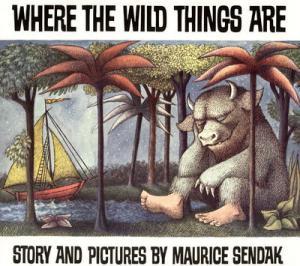
HarperCollins, 25th Anniversary Edition, December 2012.
I recently looked through a list of controversial or banned books, and smiled a little, realizing how many I read to my children. How we both learned so much in the process. How those moments—tucked under the same quilt, small head resting on my chest, breathing in unison as I read aloud—were my best as a mother.
WHERE THE WILD THINGS ARE taught us that some times our own anger is monstrous.
CHARLOTTE’S WEB taught us that friends find extraordinary strength for each other.
THE GIVER showed us the beauty in pain.
A WRINKLE IN TIME proved the power of individuality.
THE BRIDGE TO TERABITHIA taught us that childhood is sacred.
Yet that day, when my daughter became a Z, I took a book out of her hands. She had darted up the stairs to our bookcases and pulled SPEAK by (my hero) Laurie Halse Anderson from the shelf.
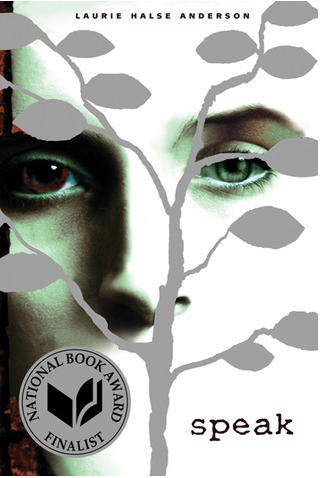
Squarefish, Reprint Edition, May 2011.
I put it right back. Now listen, SPEAK is a magnificent book, an important book that changed my life. Everyone should read this book. I mean it.
But everyone should read it when they’re ready to read it. And she wasn’t ready. Yet.
So how is a parent to know when a book belongs in the Not Yet pile? It’s pretty simple actually. My son’s second-grade teacher framed it best: “If he can talk about it, he can read about it.” And she wasn’t ready to talk about it. Some young readers would’ve been fine. She’s wouldn’t have been. Yet.
The themes in SPEAK—about trauma and secrets—would’ve blistered my girl if she read it too soon. Or worse, she wouldn’t have understood it. Her arms wouldn’t have erupted with goosebumps when Melinda found her voice. The story would’ve been about rape to her, not about empowerment. Not about recovery. The opportunity for empathy and growth would’ve been swindled from us both.
Trust me, I’d much prefer my children’s exposure to tough ideas and injustices be through a book that can be put down and pondered and returned to rather than the visual onslaught of a movie or—worst of all—actual experience.
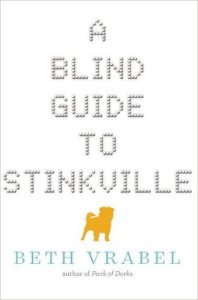
Sky Pony Press, October 2015.
As a writer, it’s painful—actually painful—to deny a book to my children. I vehemently and ardently believe that age ranges on jackets are suggestions, not orders. I bristle at stories I’ve heard of teachers forcing kids to finish books they don’t like because the titles were deemed “just right” for them. I can’t imagine a faster, more thorough way to squash a love of reading.
But as a mother? I have to protect their developing minds. And some content? It’s just not appropriate. Yet.
This spring—more than a year and many discussions after pulling SPEAK from my daughter’s hands, I slid the book off the shelf and handed it to my daughter. She read it in a day and a half.
Her takeaway from Melinda’s story? “Not talking about what happened to her didn’t help her at all.” (Dear Lord, please, please, please, don’t ever let my baby live through Melinda’s story. But do let her learn from that book. Do keep her talking.)
I make a lot of mistakes as a parent. I’m the mom who forgets to bring a water bottle to soccer practice. I blanked on the recorder concert (total accident, I swear). I yell more than I should and spend too much time picking apart what needs to improve instead of celebrating what’s glistening in front of me. I rely on my village.
But when it comes to what my child is reading? I’ve got this.
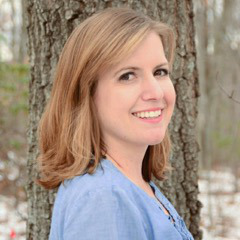
Beth Vrabel.
Beth Vrabel grew up in a small town in Pennsylvania. She won a short-story contest in fourth grade and promptly decided writing was what she was going to do with her life. Although her other plans—becoming a wolf biologist, a Yellowstone National Park ranger, and a professional roller skater—didn’t come to fruition, she stuck with the writing. After graduating from Pennsylvania State University with a degree in journalism, she moved through the ranks of a local newspaper to become editor of two regional magazines and a lifestyle columnist. She is the author of PACK OF DORKS (Sky Pony Press, 2014) and A BLIND GUIDE TO STINKVILLE (Sky Pony Press, 2015). Beth lives with her wonderful husband, two charming children, a spoiled rotten puppy, and Frodo the guinea pig in Canton, Connecticut.








